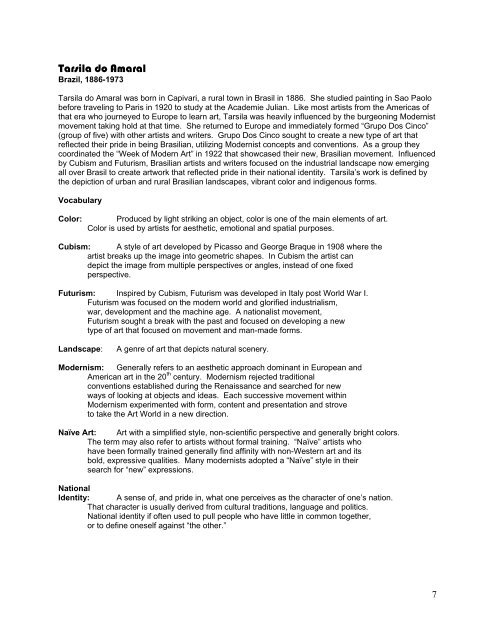Frida Kahlo - Faculty Web Pages
Frida Kahlo - Faculty Web Pages
Frida Kahlo - Faculty Web Pages
You also want an ePaper? Increase the reach of your titles
YUMPU automatically turns print PDFs into web optimized ePapers that Google loves.
Tarsila do Amaral<br />
Brazil, 1886-1973<br />
Tarsila do Amaral was born in Capivari, a rural town in Brasil in 1886. She studied painting in Sao Paolo<br />
before traveling to Paris in 1920 to study at the Academie Julian. Like most artists from the Americas of<br />
that era who journeyed to Europe to learn art, Tarsila was heavily influenced by the burgeoning Modernist<br />
movement taking hold at that time. She returned to Europe and immediately formed “Grupo Dos Cinco”<br />
(group of five) with other artists and writers. Grupo Dos Cinco sought to create a new type of art that<br />
reflected their pride in being Brasilian, utilizing Modernist concepts and conventions. As a group they<br />
coordinated the “Week of Modern Art” in 1922 that showcased their new, Brasilian movement. Influenced<br />
by Cubism and Futurism, Brasilian artists and writers focused on the industrial landscape now emerging<br />
all over Brasil to create artwork that reflected pride in their national identity. Tarsila’s work is defined by<br />
the depiction of urban and rural Brasilian landscapes, vibrant color and indigenous forms.<br />
Vocabulary<br />
Color: Produced by light striking an object, color is one of the main elements of art.<br />
Color is used by artists for aesthetic, emotional and spatial purposes.<br />
Cubism: A style of art developed by Picasso and George Braque in 1908 where the<br />
artist breaks up the image into geometric shapes. In Cubism the artist can<br />
depict the image from multiple perspectives or angles, instead of one fixed<br />
perspective.<br />
Futurism: Inspired by Cubism, Futurism was developed in Italy post World War I.<br />
Futurism was focused on the modern world and glorified industrialism,<br />
war, development and the machine age. A nationalist movement,<br />
Futurism sought a break with the past and focused on developing a new<br />
type of art that focused on movement and man-made forms.<br />
Landscape: A genre of art that depicts natural scenery.<br />
Modernism: Generally refers to an aesthetic approach dominant in European and<br />
American art in the 20 th century. Modernism rejected traditional<br />
conventions established during the Renaissance and searched for new<br />
ways of looking at objects and ideas. Each successive movement within<br />
Modernism experimented with form, content and presentation and strove<br />
to take the Art World in a new direction.<br />
Naïve Art: Art with a simplified style, non-scientific perspective and generally bright colors.<br />
The term may also refer to artists without formal training. “Naïve” artists who<br />
have been formally trained generally find affinity with non-Western art and its<br />
bold, expressive qualities. Many modernists adopted a “Naïve” style in their<br />
search for “new” expressions.<br />
National<br />
Identity: A sense of, and pride in, what one perceives as the character of one’s nation.<br />
That character is usually derived from cultural traditions, language and politics.<br />
National identity if often used to pull people who have little in common together,<br />
or to define oneself against “the other.”<br />
7


